You’ll need to choose between ANT+ and Bluetooth Smart protocols when connecting speed sensors to your sport watch. ANT+ supports multiple simultaneous connections and consumes less power, while Bluetooth Smart offers faster data transfer but limits one-to-one pairing. Most Garmin devices support both protocols, while COROS watches only accept Bluetooth accessories. Wake your sensor by spinning the wheel, make certain you’re within 3 meters, and access your watch’s sensor settings to add the device. Understanding these fundamentals will help you optimize your cycling performance tracking setup.
Understanding ANT+ and Bluetooth Smart Communication Protocols
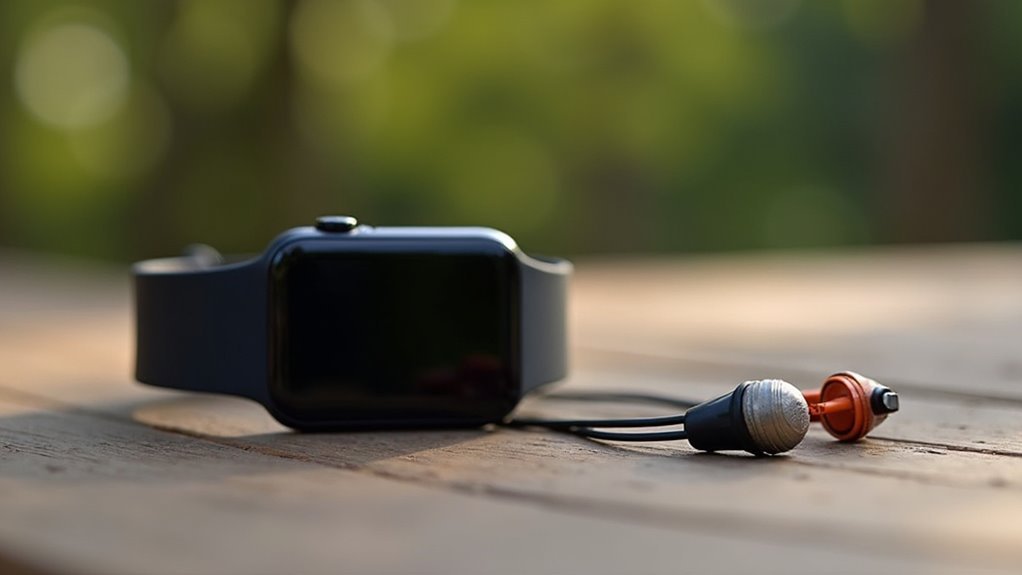
When you’re connecting speed sensors to your sport watch, you’ll encounter two primary communication protocols: ANT+ and Bluetooth Smart (BLE).
Both operate on the 2.4 GHz ISM band but differ greatly in their communication approach. ANT+ supports point-to-multipoint connections, letting multiple devices receive data from one sensor simultaneously—perfect when you’re using multiple monitors or sharing data with teammates.
ANT+ enables one sensor to broadcast data to multiple devices simultaneously, making it ideal for team training and multi-device setups.
Bluetooth Smart uses point-to-point connections, restricting one sensor to one receiver at a time.
You’ll find ANT+ consumes less power, extending your sensor’s battery life, while BLE offers faster data transfer rates up to 2 Mbps compared to ANT+’s 12.8 Kbps.
BLE connects more quickly and works with smartphones and tablets, whereas ANT+ excels in professional fitness environments requiring multiple simultaneous connections. ANT+ also provides superior mesh networking capabilities that enable more complex device interconnection scenarios.
Compatibility Between Major Sport Watch Brands and Speed Sensors
While most modern sport watches support multiple communication protocols, you’ll discover that compatibility between your watch brand and speed sensors isn’t always guaranteed.
Each manufacturer has specific limitations that’ll affect your sensor choices.
Here’s how major brands handle speed sensor compatibility:
- Garmin devices offer the most versatility, supporting both ANT+ and Bluetooth Smart protocols with seamless pairing to their Speed Sensor V2.
- Coros watches only support Bluetooth accessories, lacking ANT+ compatibility which limits your speed sensor options considerably.
- Polar watches can encounter issues with certain speed sensors, particularly Garmin models, despite supporting multiple protocols.
Suunto and Wahoo devices generally work well with various speed sensors supporting both ANT+ and Bluetooth.
You’ll need to verify protocol compatibility before purchasing any speed sensor for your specific watch model. Some sport watches can experience connection limitations where only one sensor can be paired at a time, forcing you to choose between speed or cadence functionality.
Step-by-Step Pairing Process for Garmin Devices
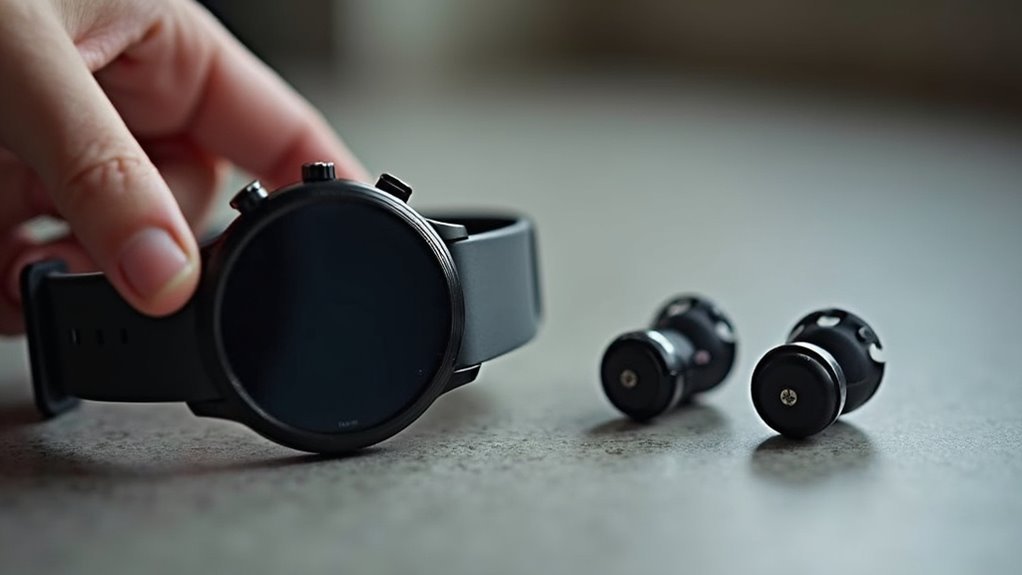
Since Garmin devices offer the most versatile sensor compatibility, you’ll find their pairing process relatively straightforward once you understand the key steps.
First, position your Garmin within 3 meters of the speed sensor and guarantee you’re at least 10 meters from other wireless devices. Wake the sensor by rotating your bike wheel two full revolutions—watch for a green LED flash confirming activity.
Position your Garmin within 3 meters of the sensor, then wake it by rotating your wheel twice.
Access your Garmin’s settings menu and select “Add Sensor” or similar option. Choose the speed sensor type when prompted. Your device will search for the sensor via ANT+ or Bluetooth. When the sensor appears in the search list, confirm the selection to establish pairing.
Test the connection by starting an activity and verifying speed data displays correctly during wheel rotation. Once successfully paired, your device will automatically recognize the sensor each time you activate it for future rides.
Connecting COROS Speed Sensors to Your Wearable Device
COROS speed sensors follow a similar straightforward approach but rely exclusively on Bluetooth connectivity rather than ANT+.
You’ll find the pairing process quick and intuitive through your COROS watch’s menu system.
To connect your COROS speed sensor:
- Navigate to pairing: Go to System > Accessories > Add Bluetooth on your COROS watch
- Complete the connection: Select your speed sensor from the available devices list
- Configure wheel circumference: Enter your bike’s wheel circumference for accurate distance measurements
Your COROS speed sensor can simultaneously connect to two Bluetooth devices, making it versatile for multi-device setups.
The sensor works seamlessly with COROS DURA and other COROS watches, providing real-time speed and distance data. COROS sensors are currently available in Canada, the United Kingdom, and the United States.
You can adjust wheel circumference settings even after initial pairing.
Suunto Watch Integration With Bike Speed Sensors
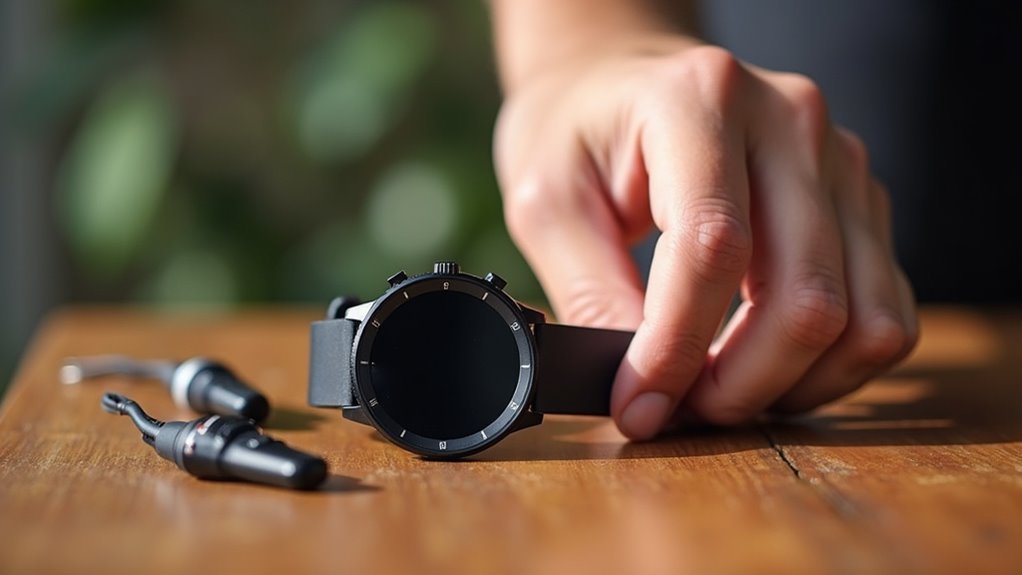
Although Suunto takes a more selective approach to speed sensor compatibility, the pairing process remains straightforward for supported devices.
You’ll find newer models like Suunto 9, Suunto Baro, and Suunto Racer work seamlessly with bike speed sensors, while older models such as first-generation Ambit, Quest, and M-Series don’t support this functionality.
Your Suunto watch connects to sensors via Bluetooth, measuring speed, distance, and cadence.
However, you can only pair one bike sensor at a time. Third-party sensors from Garmin or Magene may work, but they’re typically limited to speed data only—cadence information often won’t transmit. When setting up your bike sensors, select “Pair bike POD” to ensure proper recognition during the initial pairing process.
For ANT+ sensors, you’ll need a bridge device since Suunto watches don’t support direct ANT+ connections.
This limitation makes sensor selection vital for ideal performance.
Troubleshooting Common Connection Issues
When your Suunto watch won’t connect to your bike speed sensor, you’re likely dealing with one of three main culprits.
Signal interference from nearby devices, pairing failures between your watch and sensor, or battery connection problems can all disrupt the connection process. Before troubleshooting connection issues, ensure your speed sensor shows a flashing green LED to confirm it’s properly activated and ready for pairing.
Let’s tackle each issue systematically so you can get back to tracking your rides without frustration.
Signal Interference Problems
Signal interference represents one of the most frustrating obstacles you’ll encounter when connecting speed sensors to your sport watch. Multiple sources can disrupt your sensor’s reliability, from previously paired devices and wireless routers to exercise equipment with motors and LED displays.
Common interference culprits include:
- Electronic devices – Bluetooth gadgets, wireless speakers, smart TVs, and microwave ovens emit electromagnetic fields that degrade sensor signals.
- Physical barriers – Your body, metal objects, walls, and countertops block transmission when positioned between sensor and watch.
- Exercise equipment – Treadmills, indoor bikes, and fans generate stray signals that disrupt connectivity.
You can resolve these issues by unpairing unused devices, relocating your sensor away from interference sources, and maintaining less than five feet between your sensor and watch. Before attempting to reconnect, always restart your phone and close all open applications to ensure a clean connection environment.
Device Pairing Failures
While interference issues can disrupt your sensor’s signal quality, device pairing failures prevent any connection from establishing in the first place.
You’ll need to unpair your speed sensor from all previously connected devices first, as sensors typically support only one Bluetooth connection at a time.
Check that your watch has Bluetooth Smart (BLE) support and runs compatible software versions.
Wake up your sensor by placing a magnet near it or spinning your bike pedal, ensuring you’re within five feet during pairing.
Replace batteries even if they seem functional, as poor contact quality causes connection failures. Clean the battery contacts to remove any coating or debris that might prevent proper electrical connection.
If problems persist, try pairing with another device to verify your sensor’s hardware isn’t defective.
Battery Connection Issues
Beyond pairing problems, battery connection issues create another common source of sensor malfunctions that can leave you frustrated during workouts.
Low or weak batteries cause intermittent signals, repeated disconnections, and erratic data transmission. You’ll notice your sensor dropping connections frequently or not being detected at all.
Here’s how to resolve battery-related connection problems:
- Test with a fresh battery – Replace with a new CR2032 or recommended coin cell to eliminate power issues
- Clean battery contacts – Remove dirt and corrosion from the compartment that affects electrical connection
- Reset the sensor – Insert the battery upside down for three seconds, then flip it to correct polarity
Ensure you’re using quality batteries and replacing them every 6-24 months based on usage patterns. This battery reset procedure is crucial for fully resetting the sensor’s electronics and resolving persistent connection issues.
Optimizing Real-Time Data Transmission for Indoor Training
When training indoors, you’ll need to choose between Bluetooth and ANT+ protocols based on your specific setup and device compatibility.
Bluetooth offers broader device support and easier pairing, while ANT+ provides more reliable connections with multiple sensors simultaneously.
To maximize your real-time data accuracy, you should focus on optimizing signal strength by positioning sensors properly and minimizing interference from other wireless devices. Modern sport watches can function as comprehensive bike computers when paired with ANT+ speed and cadence sensors, transforming your indoor cycling sessions into professional-grade training experiences.
Bluetooth Vs Ant+ Protocols
As you set up your indoor training environment, choosing between Bluetooth Low Energy (BLE) and ANT+ protocols will directly impact your data quality and device connectivity.
BLE offers superior energy efficiency by transmitting only when needed, while ANT+ continuously broadcasts at 4-8 Hz frequencies, consuming more battery power.
For speed sensor connections, consider these key differences:
- Data Reliability – BLE achieves near 0% missed data points during transmission, while ANT+ may experience up to 5% packet loss.
- Device Compatibility – BLE works with all smartphones and modern sport watches, whereas ANT+ requires dedicated sports devices or dongles.
- Battery Performance – BLE’s optimized power management extends training session duration compared to ANT+’s constant broadcasting demands.
Modern sport watches can establish simultaneous connections with multiple BLE accessories, eliminating the need to disconnect devices when switching between different sensors during training.
Your protocol choice affects real-time data accuracy during critical intervals.
Signal Strength Optimization
Signal strength enhancement forms the foundation of reliable indoor training data, where even minor transmission disruptions can compromise your workout metrics. You’ll achieve ideal SNR by maintaining less than 5 feet between your sensor and watch while ensuring direct line-of-sight positioning. Place sensors close to your body’s central axis—wrist or ankle locations work best for consistent signal capture.
| Enhancement Factor | Best Practice |
|---|---|
| Distance | Keep sensor within 5 feet of watch |
| Placement | Position on wrist or ankle (central axis) |
| Environment | Avoid Wi-Fi routers and metal obstacles |
| Maintenance | Update firmware and re-pair devices regularly |
Environmental interference from concrete walls, metal beams, and electronic devices greatly degrades transmission quality. You’ll minimize packet loss by testing connections before each session and positioning sensors away from Wi-Fi routers or microwaves. When external sensors aren’t available, your watch can rely on wrist-based accelerometer measurements to track speed and distance during indoor workouts.
Battery Management and Sensor Maintenance
While your speed sensor delivers reliable performance data, its longevity depends on proper battery management and routine maintenance. Your CR2032 coin cell battery typically lasts weeks to months, but you’ll know it’s time for replacement when the LED flashes red after two revolutions.
Proper battery care and regular maintenance ensure your speed sensor continues delivering accurate performance data for months of reliable operation.
Essential maintenance practices:
- Replace batteries proactively – Don’t wait until voltage drops below 1.3V, as this can cause sensor malfunction.
- Handle the O-ring carefully – Inspect and replace it regularly to maintain waterproof integrity and prevent water damage.
- Store sensors properly – Keep them in cool, dry environments when not in use to preserve battery life. Always ensure correct polarity when installing new batteries to prevent device damage.
Turn off your sensor during extended periods of non-use, and always use manufacturer-recommended battery types for ideal compatibility and performance.
Multi-Device Pairing and Data Synchronization
Modern sport watches excel at managing connections with multiple sensors simultaneously, allowing you to pair speed, cadence, heart rate, and power meters through ANT+ or Bluetooth protocols.
You’ll find most devices support concurrent pairing, though you should check your watch’s specifications for maximum sensor limits.
Once paired, your sensors deliver real-time data streams directly to your watch during activities.
After each ride, data automatically syncs to your companion app for detailed analysis and long-term tracking. For cycling power sensors specifically, ensure you update firmware for both your watch and third-party power sensors before attempting to establish connections.
Many platforms extend this synchronization across phones, tablets, and web interfaces, ensuring your performance data remains accessible everywhere.
You can configure multiple bike profiles with custom settings like wheel size and crank length, making sensor management effortless when switching between different bikes during training sessions.
Enhancing GPS Performance With Speed Sensor Data
When GPS signals weaken under dense tree cover or between tall buildings, your speed sensor becomes an essential backup that maintains accurate tracking throughout your workout. This combination delivers consistent performance data regardless of environmental challenges.
Speed sensors excel where GPS struggles, providing three key advantages:
- Instant data processing – Real-time speed and distance tracking without satellite delays
- Battery conservation – Reduces GPS workload in poor reception areas, extending device life
- Terrain independence – Maintains accuracy in mountain trails, urban canyons, and indoor environments
Your sport watch integrates both data sources automatically, using speed sensor readings to fill GPS gaps and enhance overall measurement precision. Modern wearable technologies also support remote monitoring frameworks that extend beyond individual performance tracking.
This dual approach guarantees you’ll capture every interval, hill climb, and sprint with reliable accuracy, giving you complete confidence in your performance metrics.
Comparing Wireless Standards for Cycling Performance Tracking
Your sport watch’s ability to connect with cycling sensors depends heavily on which wireless standard it supports. ANT+ and Bluetooth Low Energy (BLE) are the two main protocols you’ll encounter. ANT+ excels at connecting multiple sensors simultaneously without interference, making it ideal for thorough data collection. BLE offers easier pairing with smartphones and frequent data updates but typically supports one-to-one connections.
| Feature | ANT+ | BLE |
|---|---|---|
| Multi-sensor support | Excellent | Limited |
| Smartphone compatibility | Requires dongle | Native |
| Battery efficiency | Superior | Good |
Most high-end sport watches now include dual ANT+/BLE radios, giving you maximum flexibility. You’ll benefit from ANT+’s stable multi-sensor environments while enjoying BLE’s seamless smartphone integration and straightforward pairing process. Professional bike computers often support over 150 operations including call alerts, real-time tracking, and comprehensive sensor integration for complete performance monitoring.
Frequently Asked Questions
Can I Use My Speed Sensor With Indoor Spin Bikes at the Gym?
You can’t effectively use standard speed sensors with gym spin bikes because they lack traditional wheels. However, you can use cadence sensors to track your RPM and improve workout monitoring instead.
How Much Does a Quality Speed Sensor Typically Cost?
You’ll typically spend $40-110 for quality bike speed sensors. Garmin’s Speed Sensor 2 costs around $38, while Polar’s speed and cadence bundle runs $109. Most reliable options fall within this range.
Will My Speed Sensor Work in Heavy Rain or Snow Conditions?
Your speed sensor will work reliably in heavy rain or snow since they’re built with waterproof casings. Just guarantee proper mounting and clean the sensor afterward to prevent residue buildup.
How Often Do I Need to Replace the Battery in My Sensor?
You’ll typically need to replace your speed sensor’s CR2032 battery every six to twelve months, depending on usage frequency and environmental conditions. Watch for flashing LED indicators signaling low battery levels.
Can One Speed Sensor Connect to Multiple Watches Simultaneously?
Yes, you can connect one speed sensor to multiple watches simultaneously if it supports ANT+ protocol. However, each watch will only use one speed sensor per workout session, automatically selecting the most recently paired device.
In Summary
You’ve now learned how to connect speed sensors to your sport watch using ANT+ and Bluetooth protocols. Whether you’re using Garmin, COROS, or Suunto devices, the pairing process remains straightforward. Don’t forget to maintain your sensor’s battery and consider multi-device capabilities for seamless data sync. By combining speed sensor data with GPS, you’ll achieve more accurate performance tracking and better cycling metrics for your training goals.

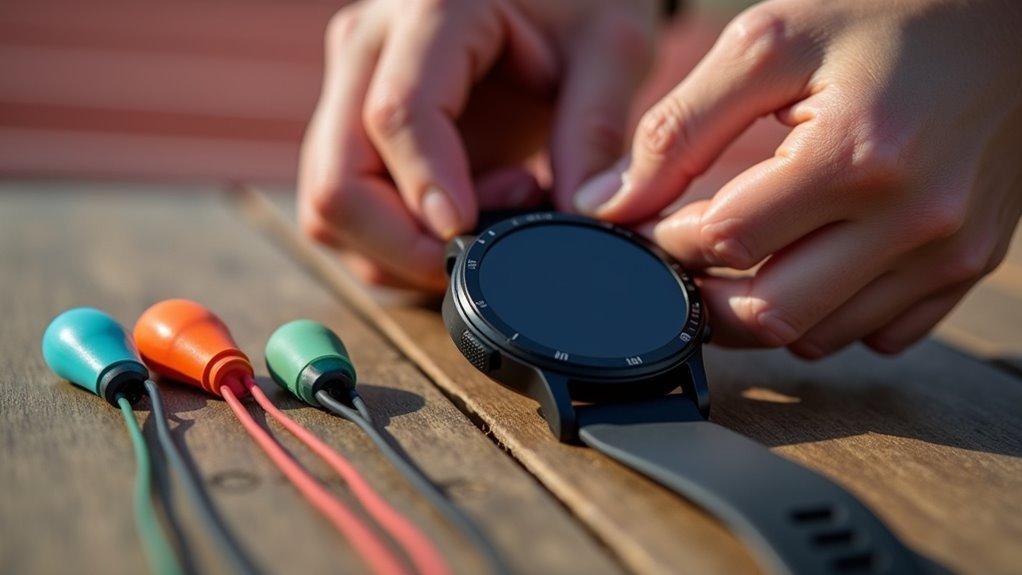
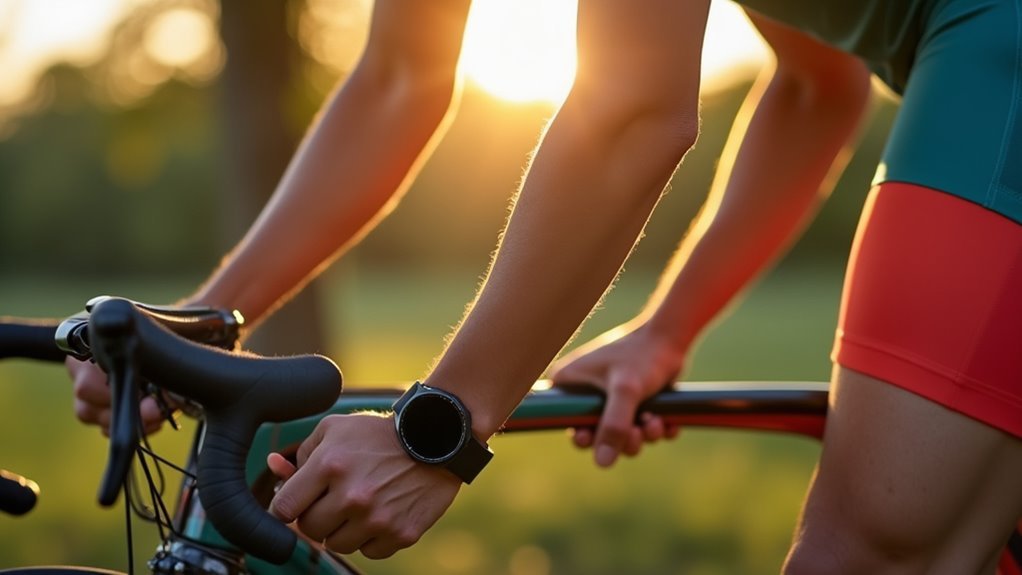
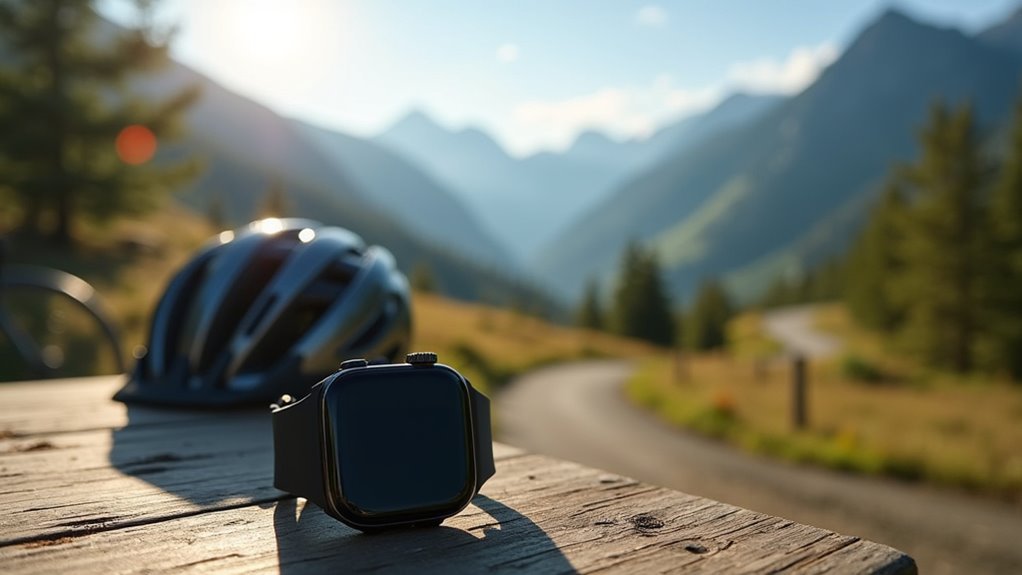
Leave a Reply